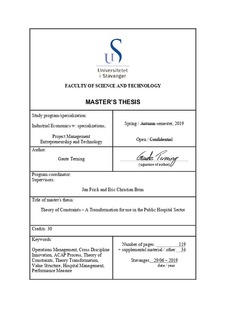| dc.description.abstract | A prerequisite for a safe and functioning society is to have an effective and well-functioning hospital. Hospitals are large scale complex systems that we all depend upon in situations when we are on our lives are at the most critical. The hospital sector has continually changed for the last several decades and experienced a constant shift in their day-to-day work. Today, the hospitals face increased pressure caused by increasing expectations from the users and society at large. At the same time, the cost of the workforce has raised drastically for the industrialized countries, causing an increased focus on cutting the cost of running the hospitals. The demand for cost-effectiveness is even more true for the publicly provided healthcare services that for each day that goes is put under a higher degree of scrutiny. Facing challenges such as these, have required healthcare managers to develop strategies to cope.
Ever since the technical revolution that introduced the concept of dealing with large amounts of units (better known as mass production) the industry has developed and refined their methodologies and their approaches has seemed to be immensely fruitful (J. P. Womack, Jones, & Roos, 1990, p. 26). These methods have crystallized itself into its own discipline within general management into what is now known as operations management (OM). However, as one can imagine, the process of implementing and transfer these concepts and frameworks into health care is not straightforward as there are substantial differences between these two enterprises. Not to mention that operations in the manufacturing industries mainly deal with machines and goods, and the hospital sector is mainly dealing with peoples. In the forefront in this movement of improving the operations of hospitals is the Institute of Healthcare Improvement (IHI). As will be elaborated further in the next section, IHI argues for implementing OM principles to hospital operations but does not mention the potential of the Theory of Constraints in this respect.
The project encapsulated in this dissertation is going to look at the possibility to adapt the core of one of the most promising operations management methodologies; Theory of Constraints to be applicable for the hospital setting. From the Theory of Constraints-community, there seems to be a unanimous consensus that the theory will fit very well for the operation of the hospital. However, doing so necessitates a thorough and profound work of transformation. This dissertation will take the theory apart, and by using principles found in cross-industry innovation perform a new transformation of this methodology.
By using the ACAP’s process view as an overarching methodological approach, that substantiated this dissertation’s project in particular, by structuring a way of carrying out the project in a systematic way. First, through an assimilation of the theory part of this dissertation where the general theoretical landscape of operations management was reviewed. Here it was also performed a literature review of the past performed TOC-implementations to pinpoint the problem in the past implementation in the hospital setting.
The problem of this dissertation was based on the identified societies’ insatiate need for health care across the population to attempt to adjust the fruitful theory of TOC that has proven utility in the industry sector. The project of the dissertation has endeavored an attempt to fill the theoretical gap that has abstained the healthcare improvement community from using TOC in their improvement processes.
The resulting transformed value structure conceptually provided the allowance to implement into the values of the public hospital sector. Also, the resulting framework has the flexibility for several simultaneous goals, which is beneficial for an organization that can not operate solely on profit maximization and needs to have goals in addition to that. Another quality of the resulting framework is that it provides acceptance of leadership values such as trust. | nb_NO |
